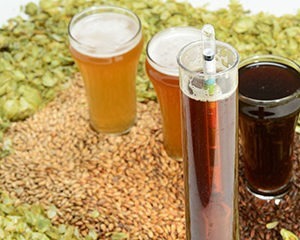Fermenter Addition Basics
Adding ingredients to your fermenter is a common practice in brewing (e.g. dry hops or cacao nibs) and there are some general guidelines that brewers should follow when such additions are being made. The two leading factors that brewers should emphasize are sanitation and oxidation.
Factor 1: Sanitation
Spoilage from microorganisms introduced to your wort or beer should be a concern with every fermenter addition that you make. But luckily for us, alcohol is lethally toxic to the vast majority of microorganisms found in our world. But organisms such as Pediococcus, Lactobacillus, and wild yeast can survive and multiply in these environments. That is why many instructions for fermenter additions will include some form of sanitation step, whether by boiling, pasteurizing, or soaking in a high-alcohol environment (such as a tincture). While it may seem prudent to sanitize everything that goes into your fermenter, you’ll find that not everything needs to be sanitized.
Factor 2: Oxidation
Minimizing the amount of oxygen that makes its way into the beer after fermentation is one of the challenges to make great beer. Luckily though, any fermenter addition made prior to the completion of fermentation will allow the still active yeast to scavenge most, if not all, of the oxygen that accidentally tags along. But if you wait until after fermentation is complete, simply dumping additions like coffee beans or dry hops into the beer will most certainly allow oxygen to be absorbed into solution. Brewers go to great lengths to minimize this, but a gentle approach to these additions is always a good idea.
Now let’s walk through various additions that brewers may utilize in their brew and how these two factors play into the decision-making process.
Addition Type 1: Dry Hops
In this IPA-laden era, dry hops are being added at almost any point in the fermentation and aging cycle. The timing of your dry hop addition will clue you into which of the two factors to focus on. Dry hops are almost never sanitized by brewers and do contain microorganisms that feasibly could spoil a batch of beer. Luckily, the microorganisms found on hops don’t like alcohol and will not survive even a moderately alcoholic environment as those found in standard beers. But when hops are added very early in the fermentation cycle, these organisms could potentially gain a foothold. While I have never heard of this actually happening, it is not something I want to leave to chance. So a sanitation step may be advised if you plan to add dry hops at the beginning or very early in the fermentation cycle. Soaking the hops in a neutral spirit bath would be your best sanitation method as boiling the hops would drive off the volatile oils found in hops.
Fermentation will also drive off many of the aforementioned volatile oils, so most dry hop additions are made at the end or after fermentation ceases. At that point, the sanitation step can now be overlooked, but oxidation is now of the greatest concern. Racking the beer onto the dry hops in a carbon dioxide purged vessel or a gentle submersion of the hops, are two popular methods among homebrewers.
Addition Type 2: Fruit
Adding fruit brings its own challenges since their skins are often loaded with microorganisms waiting for their turn to flourish on the fruit’s sugars. Canned purees can often be added direct to the fermenter, but for brewers using fresh produce, a sanitation step is needed to rid these fruit of their microorganisms. Unlike hops, I would advise this step be done no matter what part of the production cycle you are in. Soaking in a neutral spirit, or potassium metabisulfite solution, or pasteurizing the fruit are common ways brewers will sanitize their fruit additions. Oxidation is not often a concern since the yeast will become active thanks to the fruit’s natural sugars causing refermentation to occur, even if added after active fermentation. Racking the beer onto the sanitary fruit is a common practice by brewers.
Addition Type 3: Spice
Spice additions are similar to dry hop additions, with one notable exception . . . I would advise brewers to utilize a sanitation step no matter when you are adding the spice to the fermentation. Tinctures are not only a great sanitation step, but also coax the essential oils out of the spice as well as make it easy to fine-tune the spice level for each beer.
Addition Type 4: Sugar
Most often, sugar is added to the boil kettle and should not be added to the fermenter. There are exceptions to this rule, like priming sugar. Priming sugar should be boiled to create a simple syrup before adding to the fermenter or bottling bucket. Honey is another one of my exceptions. A boil can drive off those delicate aromas, so I will always add honey near the end of active fermentation. Finally I’ll add sugars to the fermenter for big imperial-style beers where yeast health can suffer if the starting gravity is too high. Pasteurizing the sugar is a good practice and, just like with fruit addition, oxidation is of lesser concern since the yeast will become active again after the sugar addition.


